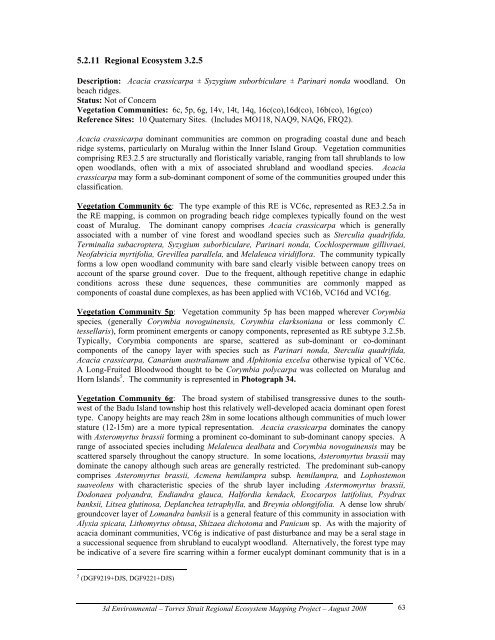Appendix 2 - Vegetation Communities and Regional Ecosystems
Appendix 2 - Vegetation Communities and Regional Ecosystems
Appendix 2 - Vegetation Communities and Regional Ecosystems
You also want an ePaper? Increase the reach of your titles
YUMPU automatically turns print PDFs into web optimized ePapers that Google loves.
5.2.11 <strong>Regional</strong> Ecosystem 3.2.5<br />
Description: Acacia crassicarpa ± Syzygium suborbiculare ± Parinari nonda woodl<strong>and</strong>. On<br />
beach ridges.<br />
Status: Not of Concern<br />
<strong>Vegetation</strong> <strong>Communities</strong>: 6c, 5p, 6g, 14v, 14t, 14q, 16c(co),16d(co), 16b(co), 16g(co)<br />
Reference Sites: 10 Quaternary Sites. (Includes MO118, NAQ9, NAQ6, FRQ2).<br />
Acacia crassicarpa dominant communities are common on prograding coastal dune <strong>and</strong> beach<br />
ridge systems, particularly on Muralug within the Inner Isl<strong>and</strong> Group. <strong>Vegetation</strong> communities<br />
comprising RE3.2.5 are structurally <strong>and</strong> floristically variable, ranging from tall shrubl<strong>and</strong>s to low<br />
open woodl<strong>and</strong>s, often with a mix of associated shrubl<strong>and</strong> <strong>and</strong> woodl<strong>and</strong> species. Acacia<br />
crassicarpa may form a sub-dominant component of some of the communities grouped under this<br />
classification.<br />
<strong>Vegetation</strong> Community 6c: The type example of this RE is VC6c, represented as RE3.2.5a in<br />
the RE mapping, is common on prograding beach ridge complexes typically found on the west<br />
coast of Muralug. The dominant canopy comprises Acacia crassicarpa which is generally<br />
associated with a number of vine forest <strong>and</strong> woodl<strong>and</strong> species such as Sterculia quadrifida,<br />
Terminalia subacroptera, Syzygium suborbiculare, Parinari nonda, Cochlospermum gillivraei,<br />
Neofabricia myrtifolia, Grevillea parallela, <strong>and</strong> Melaleuca viridiflora. The community typically<br />
forms a low open woodl<strong>and</strong> community with bare s<strong>and</strong> clearly visible between canopy trees on<br />
account of the sparse ground cover. Due to the frequent, although repetitive change in edaphic<br />
conditions across these dune sequences, these communities are commonly mapped as<br />
components of coastal dune complexes, as has been applied with VC16b, VC16d <strong>and</strong> VC16g.<br />
<strong>Vegetation</strong> Community 5p: <strong>Vegetation</strong> community 5p has been mapped wherever Corymbia<br />
species, (generally Corymbia novoguinensis, Corymbia clarksoniana or less commonly C.<br />
tessellaris), form prominent emergents or canopy components, represented as RE subtype 3.2.5b.<br />
Typically, Corymbia components are sparse, scattered as sub-dominant or co-dominant<br />
components of the canopy layer with species such as Parinari nonda, Sterculia quadrifida,<br />
Acacia crassicarpa, Canarium australianum <strong>and</strong> Alphitonia excelsa otherwise typical of VC6c.<br />
A Long-Fruited Bloodwood thought to be Corymbia polycarpa was collected on Muralug <strong>and</strong><br />
Horn Isl<strong>and</strong>s 5 . The community is represented in Photograph 34.<br />
<strong>Vegetation</strong> Community 6g: The broad system of stabilised transgressive dunes to the southwest<br />
of the Badu Isl<strong>and</strong> township host this relatively well-developed acacia dominant open forest<br />
type. Canopy heights are may reach 28m in some locations although communities of much lower<br />
stature (12-15m) are a more typical representation. Acacia crassicarpa dominates the canopy<br />
with Asteromyrtus brassii forming a prominent co-dominant to sub-dominant canopy species. A<br />
range of associated species including Melaleuca dealbata <strong>and</strong> Corymbia novoguinensis may be<br />
scattered sparsely throughout the canopy structure. In some locations, Asteromyrtus brassii may<br />
dominate the canopy although such areas are generally restricted. The predominant sub-canopy<br />
comprises Asteromyrtus brassii, Acmena hemilampra subsp. hemilampra, <strong>and</strong> Lophostemon<br />
suaveolens with characteristic species of the shrub layer including Astermomyrtus brassii,<br />
Dodonaea poly<strong>and</strong>ra, Endi<strong>and</strong>ra glauca, Halfordia kendack, Exocarpos latifolius, Psydrax<br />
banksii, Litsea glutinosa, Deplanchea tetraphylla, <strong>and</strong> Breynia oblongifolia. A dense low shrub/<br />
groundcover layer of Lom<strong>and</strong>ra banksii is a general feature of this community in association with<br />
Alyxia spicata, Lithomyrtus obtusa, Shizaea dichotoma <strong>and</strong> Panicum sp. As with the majority of<br />
acacia dominant communities, VC6g is indicative of past disturbance <strong>and</strong> may be a seral stage in<br />
a successional sequence from shrubl<strong>and</strong> to eucalypt woodl<strong>and</strong>. Alternatively, the forest type may<br />
be indicative of a severe fire scarring within a former eucalypt dominant community that is in a<br />
5 (DGF9219+DJS, DGF9221+DJS)<br />
3d Environmental – Torres Strait <strong>Regional</strong> Ecosystem Mapping Project – August 2008<br />
63


